Some Doctors Want To Change How Race Is Used In Medicine
9:51 minutes
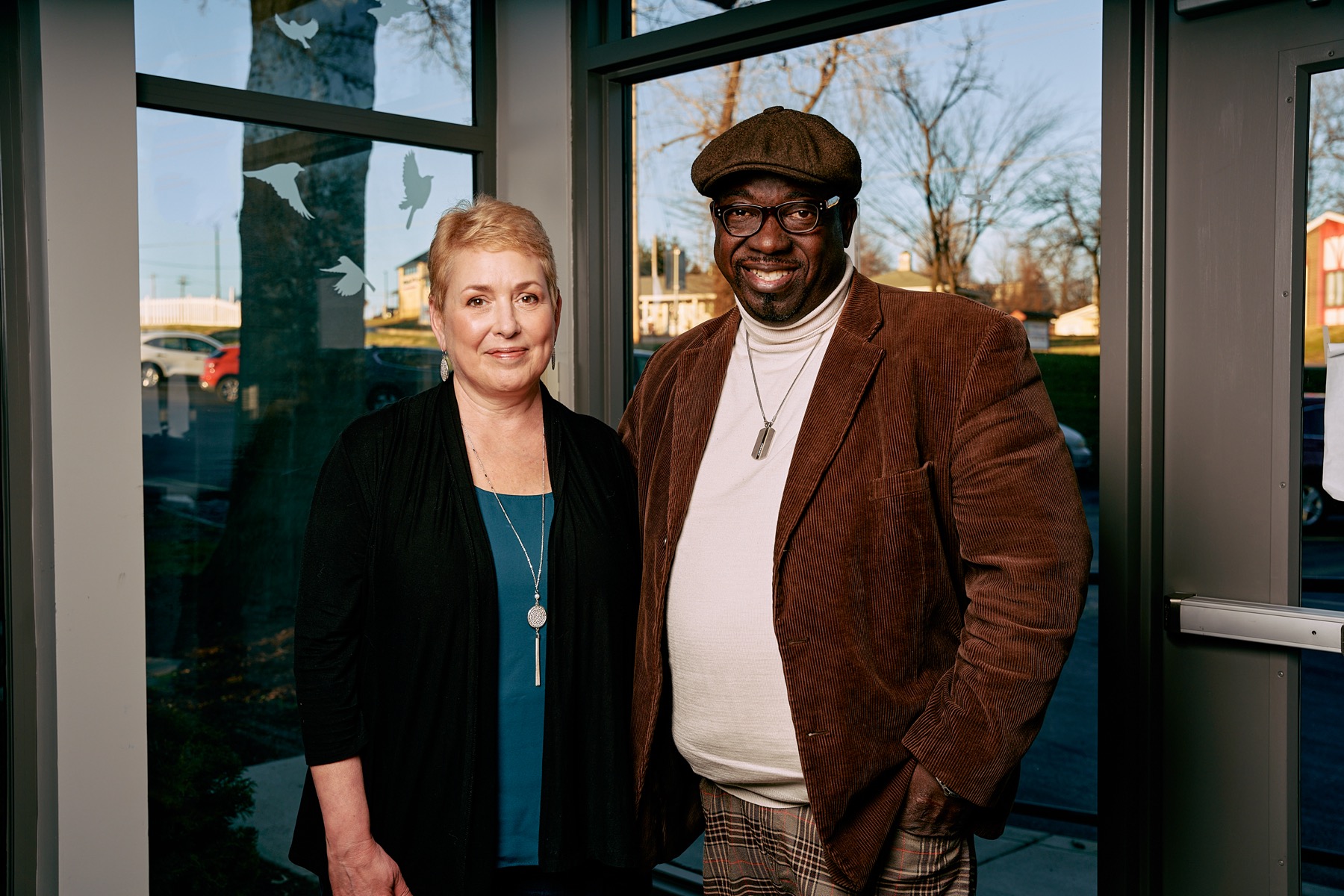
This story is a collaboration between Science Friday and KHN. It was written by Rae Ellen Bichell and Cara Anthony. In 2023, it won a National Association of Black Journalists Salute to Excellence award.
Several months ago, a lab technologist at Barnes-Jewish Hospital mixed the blood components of two people: Alphonso Harried, who needed a kidney, and Pat Holterman-Hommes, who hoped to give him one.
The goal was to see whether Harried’s body would instantly see Holterman-Hommes’ organ as a major threat and attack it before surgeons could finish a transplant. To do that, the technologist mixed in fluorescent tags that would glow if Harried’s immune defense forces would latch onto the donor’s cells in preparation for an attack. If, after a few hours, the machine found lots of glowing, it meant the kidney transplant would be doomed. It stayed dark: They were a match.
“I was floored,” said Harried.
Both recipient and donor were a little surprised. Harried is Black. Holterman-Hommes is white.
Could a white person donate a kidney to a Black person? Would race get in the way of their plans? Both families admitted those kinds of questions were flitting around in their heads, even though they know, deep down, that “it’s more about your blood type—and all of our blood is red,” as Holterman-Hommes put it.
Scientists widely agree that race is a social construct, yet it is often conflated with biology, leaving the impression that a person’s race governs how the body functions.
“It’s not just laypeople—it’s in the medical field as well. People often conflate race with biology,” said Dr. Marva Moxey-Mims, chief of pediatric nephrology at Children’s National Hospital in Washington, D.C.
She’s not talking just about kidney medicine. Race has been used as a shorthand for how people’s bodies work for years across many fields—not out of malice but because it was based on what was considered the best science available at the time. The science was not immune to the racialized culture it sprung from, which is now being seen in a new light. For example, U.S. pediatricians recently ditched a calculation that assumed Black children were less likely to get a urinary tract infection after new research found the risk had to do with a child’s history of fevers and past infections—not race. And obstetricians removed race and ethnicity from a calculation meant to gauge a patient’s ability to have a vaginal birth after a previous cesarean section, once they determined it was based on flawed science. Still, researchers say those race-based guidelines are just a slice of those being used to assess patients, and are largely based on the assumption that how a person looks or identifies reflects their genetic makeup.
Race does have its place during a doctor’s visit, however. Medical providers who give patients culturally competent care—the act of acknowledging a patient’s heritage, beliefs, and values during treatment—often see improved patient outcomes. Culturally competent doctors understand that overt racism and microaggressions can not only cause mental distress but also that racial trauma can make a person physically sick. Race is a useful tool for identifying population-level disparities, but experts now say it is not very useful in making decisions about how to treat an individual patient.
Because using race as a medical shorthand is at best imprecise and at worst harmful, a conversation is unfolding nationally among lawmakers, scientists, and doctors who say one of the best things patients can do is ask if—and how—their race is factored into their care.
Doctors and researchers in kidney care have been active recently in reevaluating their use of race-based medical guidance.
“History is being written right now that this is not the right thing to do and that the path forward is to use race responsibly and not to do it in the way that we’ve been doing in the past,” says Dr. Nwamaka Eneanya, a nephrologist with Fresenius Medical Care, who in a previous position with the University of Pennsylvania traced in the journal Nature the history of how race — a social construct— became embedded in medicine.
The perception that there is such a thing as a “Black” or “white” kidney quietly followed patient and donor as Harried and Holterman-Hommes were on the path to the transplant—in their medical records and in the screening tests recommended.
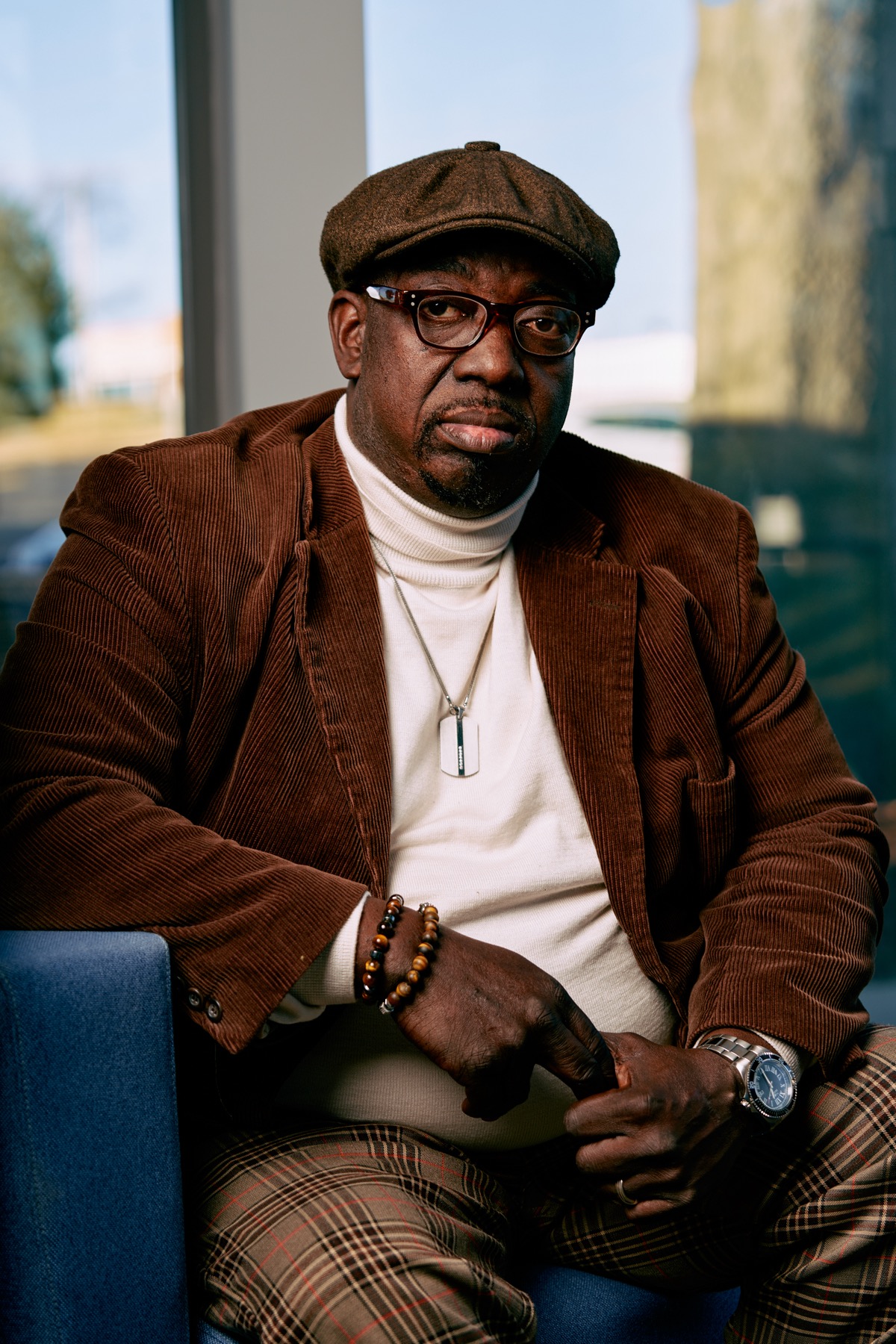
Medical records described Harried as a “47-year-old Black or African American male” and Holterman-Hommes as a “58-year-old, married Caucasian female.” Harried does not recall ever providing his race or speaking with his physicians about the influence of race on his care, but for two years or more his classification as “Black or African American” was a factor in the equations doctors used to estimate how well his kidneys were working. As previous KHN reporting lays out, that practice—distinguishing between “Black” and “non-Black” bodies—was the norm. In fall 2021, a national committee determined race has no place in estimating kidney function, a small but significant step in revising how race is considered.
Dr. Lisa McElroy, a surgeon who performs kidney transplants at Duke University, said the constant consideration of race “is the rule, not the exception, in medicine.”
“Medicine or health care is a little bit like art. It reflects the culture,” she said. “Race is a part of our culture, and it shows up all through it—and health care is no different.”
McElroy no longer mentions race in her patients’ notes, because it “really has no bearing on the clinical care plan or biology of disease.”
Still, such assumptions extend throughout health care. Some primary care doctors, for example, continue to hew to an assumption that Black patients cannot handle certain kinds of blood pressure medications, even while researchers have concluded those assumptions don’t make sense, distract doctors from considering factors more important than race—like whether the patient has access to nutritious food and stable housing—and could prevent patients from achieving better health by limiting their options.
Studying population-level patterns is important for identifying where disparities exist, but that doesn’t mean people’s bodies innately function differently—just as population-level disparities in pay do not indicate one gender is fundamentally more capable of hard work.
“If you see group differences … they’re usually driven by what we do to groups,” said Dr. Keith Norris, not by innate differences in those groups. Still, medicine often continues to use race as a crude catchall, said Norris, a UCLA nephrologist, “as if every Black person in America experiences the same amount and the same quantity of structural racism, individualized racism, internalized racism, and gene polymorphisms.”
In Harried and Holterman-Hommes’ case, one striking example of race being used as shorthand for determining how people’s bodies work was an informational guide given to Holterman-Hommes that said African Americans with high blood pressure could not donate an organ, but Caucasians with high blood pressure might still qualify.
“I can’t believe they actually wrote that down,” said Dr. Vanessa Grubbs, a nephrologist at the University of California-San Francisco. That worries Grubbs because using race as a reason to exclude donors can create a situation in which Black transplant recipients have to work harder to find a living donor than others would.
“I do think that criteria such as these become barriers for transplantation,” said Dr. Rajnish Mehrotra, head of nephrology at the University of Washington. He said that type of hypertension distinction could exclude potential donors—like the 56% of Black adults with high blood pressure in the U.S.—when more of them are sorely needed.
The inclusion of race did not necessarily affect Harried’s ability to receive a kidney, nor Holterman-Hommes’ ability to give him one. But following their case offers a glimpse into the ways race and biology are often cemented together.
Harried and Holterman-Hommes met 20 years ago when they worked together at a nonprofit that serves youth experiencing homelessness in St. Louis. Harried was the guy who pulled kids out of their ruts and into a creative mindset, from which they would write poems and songs and do artwork. Holterman-Hommes said he was “the calm in their storm.” Harried calls Holterman-Hommes “big stuff” because she is the nonprofit’s CEO who keeps the lights on and the donations coming in. “You never knew that she was the president of the company,” said Harried. “There wasn’t an air about her.”
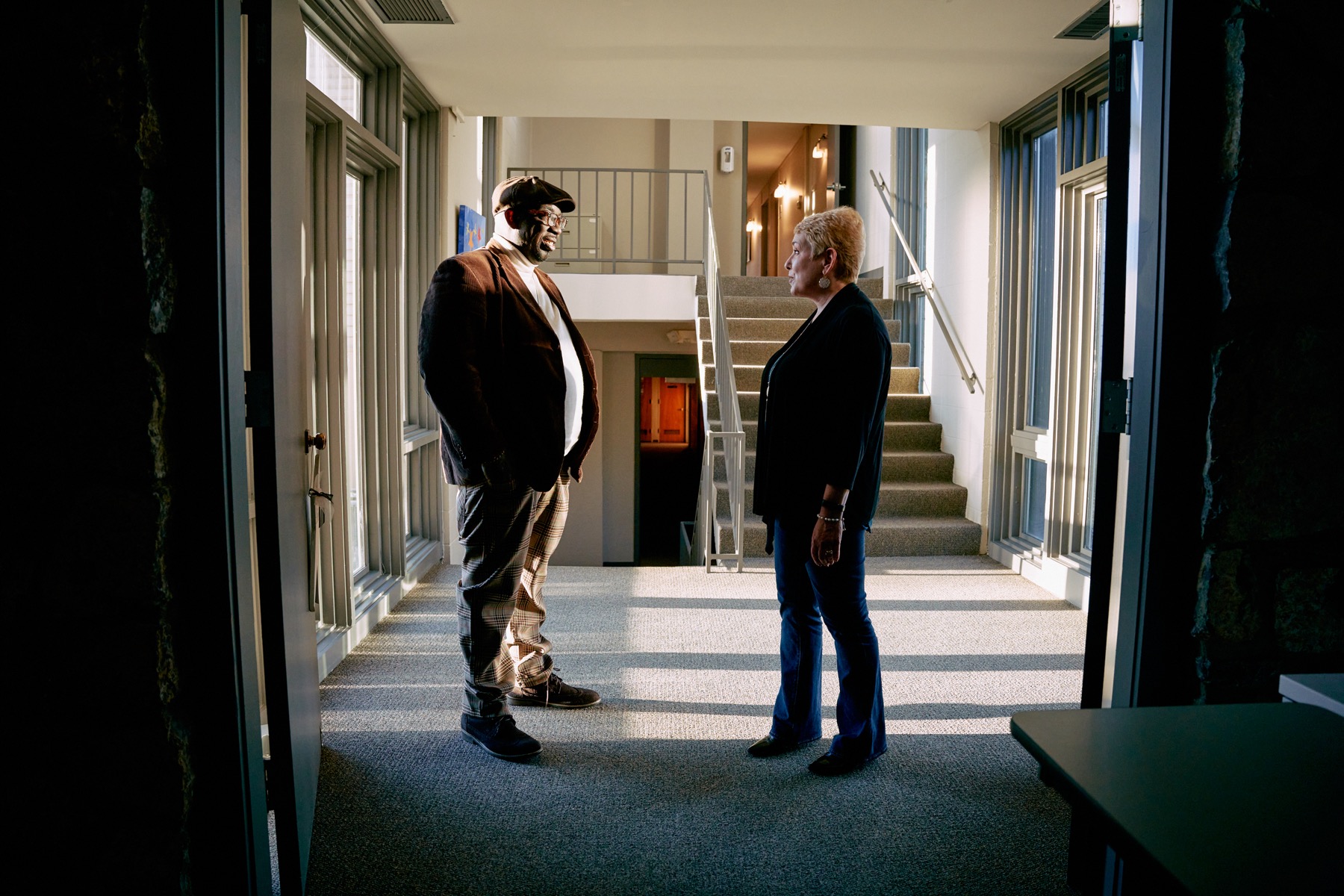
Harried resigned in 2018 as his health declined. Then in 2021, Holterman-Hommes saw a KHN article about Harried and decided to see if she could help her former colleague. Although Holterman-Hommes’ mother was born with one kidney, she had lived a long and healthy life, so Holterman-Hommes figured she could spare one of her own.
As Holterman-Hommes explored becoming a donor candidate, initial tests showed high blood pressure readings, in addition to lower-than-ideal kidney function. But “I like to get an A on a test,” she said, so she redid both sets of tests, repeating the kidney function test after staying better hydrated and the blood pressure test after a big work deadline had passed. She moved on in the screening process after her results improved.
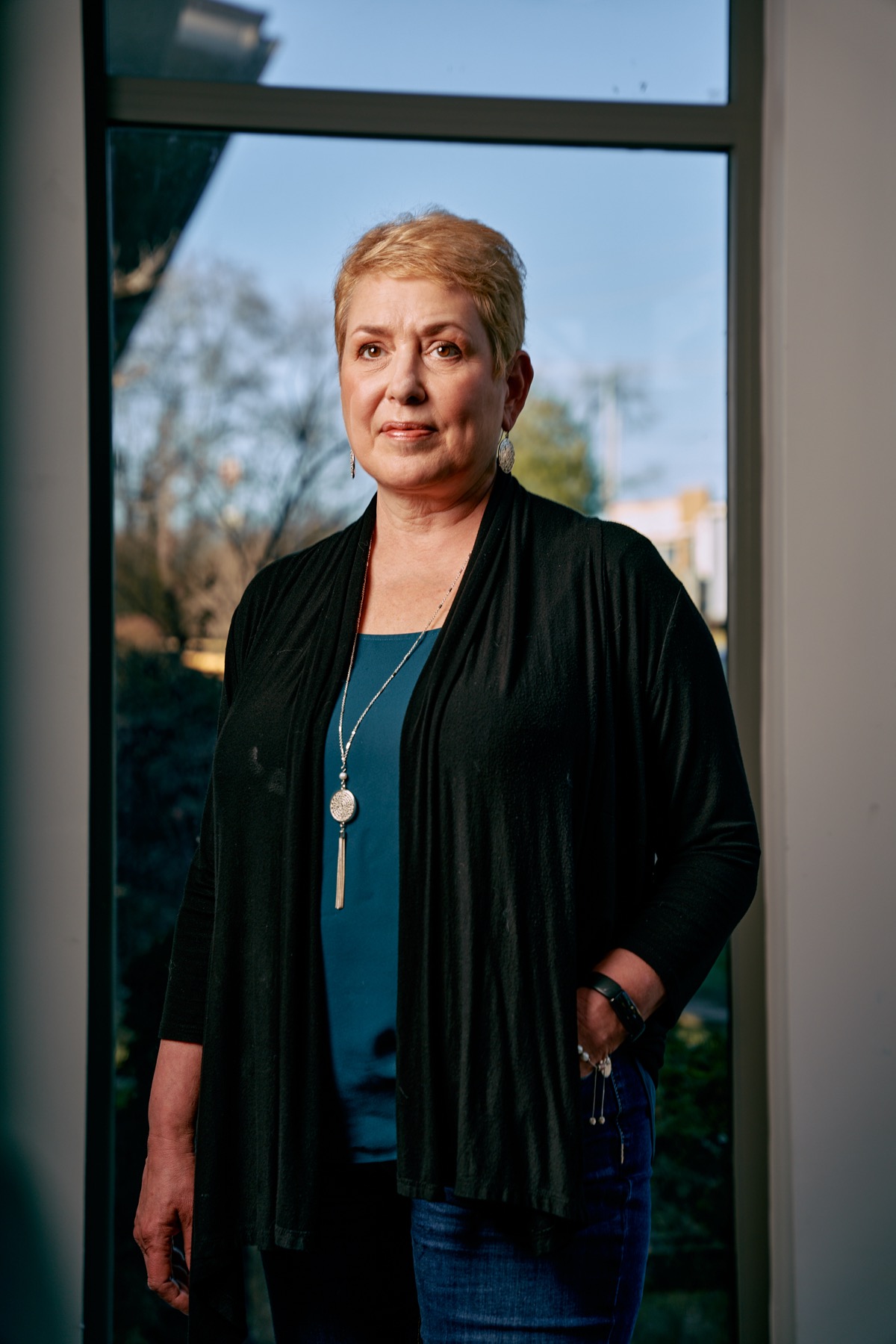
Grubbs wonders whether, if Holterman-Hommes had been Black, “they would have just dismissed her.” Grubbs shared an instance in which she suspects that’s exactly what happened to the wife of a patient of hers in California who needed a kidney transplant.
The wife, who is Black and was in her 50s at the time, wasn’t allowed to give the patient a kidney because of her hypertension.
“There are people in this country that will tell you that, ‘Oh, white people donate kidneys, Black people don’t donate kidneys, and that’s not true,’” said Mehrotra. “You hear that racist trope. But [there are] all of these barriers to kidney donation.”
Barnes-Jewish Hospital later said it had given Holterman-Hommes an outdated guide, “an unfortunate circumstance that is being corrected,” and provided a new one that does not say Black people with hypertension cannot donate. Instead, it says that people cannot donate if they have hypertension that was either diagnosed before age 40 or requires more than one medication to manage.
But “at some point, it was a policy,” said Harried, whose kidneys have been failing for several years. And it’s unclear how many years that “outdated” guidance shaped perceptions among those seeking care at Barnes-Jewish, which performs more living-donor kidney transplants per year than any other location in Missouri, according to the Scientific Registry of Transplant Recipients.
There is little transparency into how medical centers incorporate race into their decision-making and care. Guidelines from the United Network for Organ Sharing, the national organization in charge of the transplant system, leave the door open for hospitals to “exclude a donor with any condition that, in the hospital’s medical judgment, causes the donor to be unsuitable for organ donation.”
Tanjala Purnell, an epidemiologist at the Johns Hopkins Bloomberg School of Public Health studying disparities in kidney transplantation, said she knows of several centers that used race-based criteria, though some have relaxed those rules, instead deciding case by case. “There’s not a standard set to say, ‘Well, no, you can absolutely not have different rules for different people,’” she said. “We don’t have those safeguards.” Dr. Tarek Alhamad, medical director of the kidney program at the Washington University and Barnes-Jewish Transplant Center, said race-based criteria for kidney donations aren’t created to exclude Black people—it was born of a desire to avoid harming them.
“African Americans are more likely to have end-stage renal disease, they are more likely to have end-stage renal disease related to hypertension. And they are more likely to have genetic factors that would lead to kidney dysfunction,” said Alhamad.
Compared with white and Hispanic donors, non-Hispanic Black donors are known to be at higher risk for developing kidney failure because of their donation, though it’s still very rare.
He said it feels unethical to take a kidney from someone who may really need it down the line. “This is our role as physicians not to do harm.”
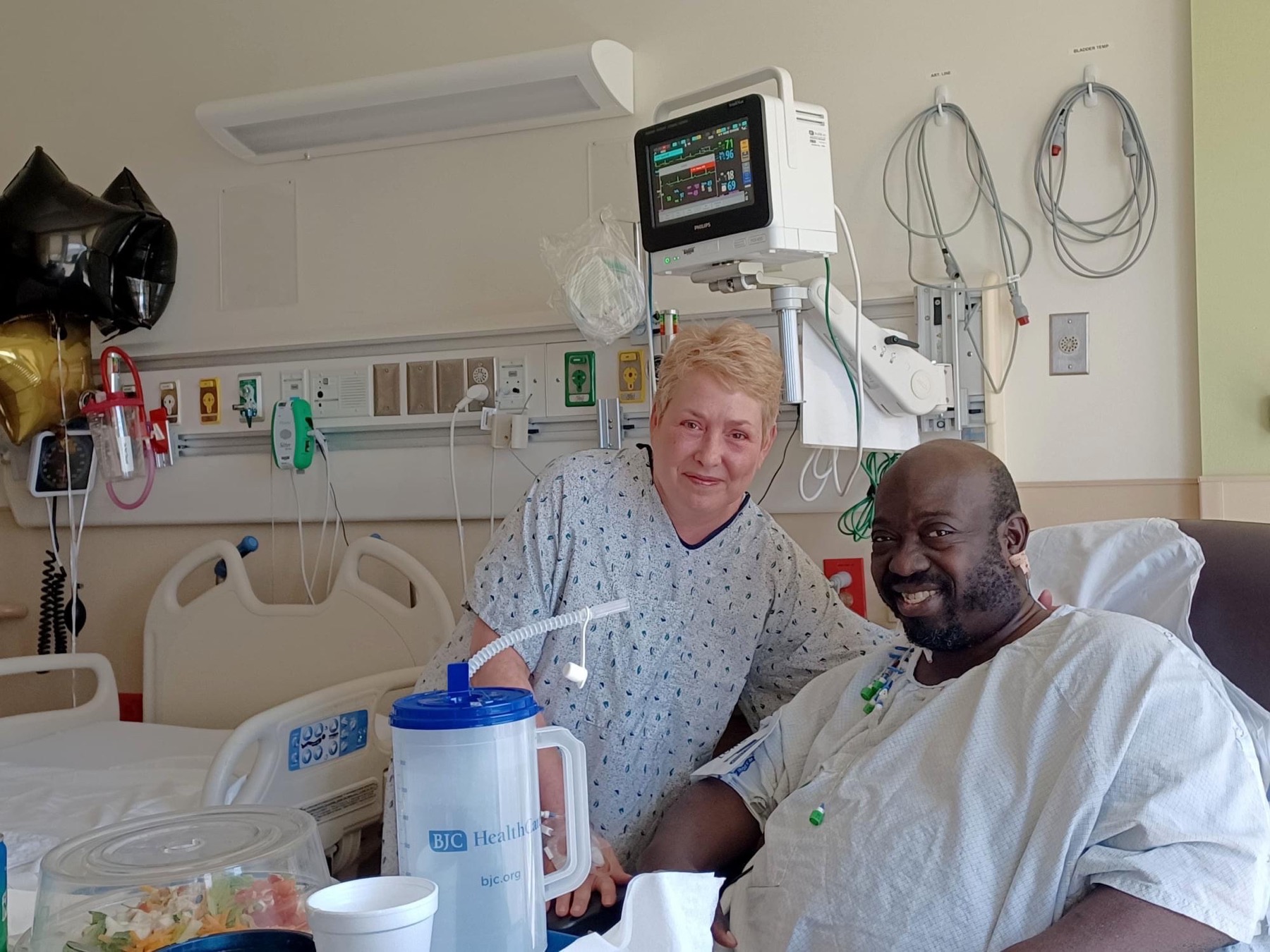
Researchers are studying a possible way to clarify who is really at risk in donating a kidney, by identifying specific risk factors rather than pinning odds on the vague concept of race.
Specifically, a gene called APOL1 could influence a person’s likelihood of developing kidney disease. All humans have two copies of this gene, but there are different versions, or variants, of it. Having two risk variants increases the chance of kidney injury.
The risk variants are most prevalent in people with recent African ancestry, a group that crosses racial and ethnic boundaries. About 13% of African Americans have the double whammy of two risk variants, said Dr. Barry Freedman, chief of nephrology at the Wake Forest School of Medicine. Even then, he said, their fate isn’t sealed—most people in that group won’t get kidney failure. “We think they need a second hit, like HIV infection, or lupus, or covid-19.”
Freedman is leading a study that looks, in part, at how kidney donors with those risk variants fare in the long term.
“This is really important because the hope is that kidneys won’t be discarded or turned down as frequently,” said Moxey-Mims, who is also involved in the research.
Researchers who are focused on health equity say that while APOL1 testing could help separate race from genetics, it could be a double-edged sword. Purnell pointed out that if APOL1 is misused—for example, if a transplant center makes a blanket rule that no one with two risk variants can donate, rather than using it as a starting point for shared decision-making, or if doctors offer the test based only on a patient’s looks—it could merely add another criterion to the list by which certain people are excluded.
“We have to do our due diligence,” said Purnell, to ensure that any effort to be protective doesn’t end up “making the pool of available donors for certain groups smaller and smaller and smaller.” Purnell, McElroy, and others steeped in transplant inequities say that as long as race—which is a cultural concept defining how someone identifies, or how they are perceived—is used as a stand-in for someone’s ancestry or genetics, the line between protecting and excluding people will remain fuzzy.
“That’s the heart of the matter here,” said McElroy.
So where does race belong in kidney transplant medicine? Many of the physicians interviewed for this article—many of them people of color—said it primarily serves as a potential indicator of hurdles patients may face, rather than as a marker of how their bodies function.
For example, McElroy said she might spend more time with Black patients building trust with them and their families, or talking about how important living donations can be, similar to the ways she might spend more time with a Spanish-speaking patient making sure they know how to access a translator, or with an elderly patient emphasizing how important physical activity is.
“The purpose is not to ignore the social determinants of health—of which race is one,” she said. “It’s to try to help them overcome the race-specific or ethnicity-specific barriers to receiving excellent care.”
While all the science gets sorted out, Eneanya is trying to get the message out to patients: “Just ask the question: ‘Is my race being used in my clinical care?’ And if it is, first of all, what race is in the chart? Is it affecting my care? And what are my options?”
“Just keep your eyes open, ask questions,” said Harried.
In late April, a kidney from Holterman-Hommes’ body was successfully placed into Harried’s. Both are home now and say they are doing well.
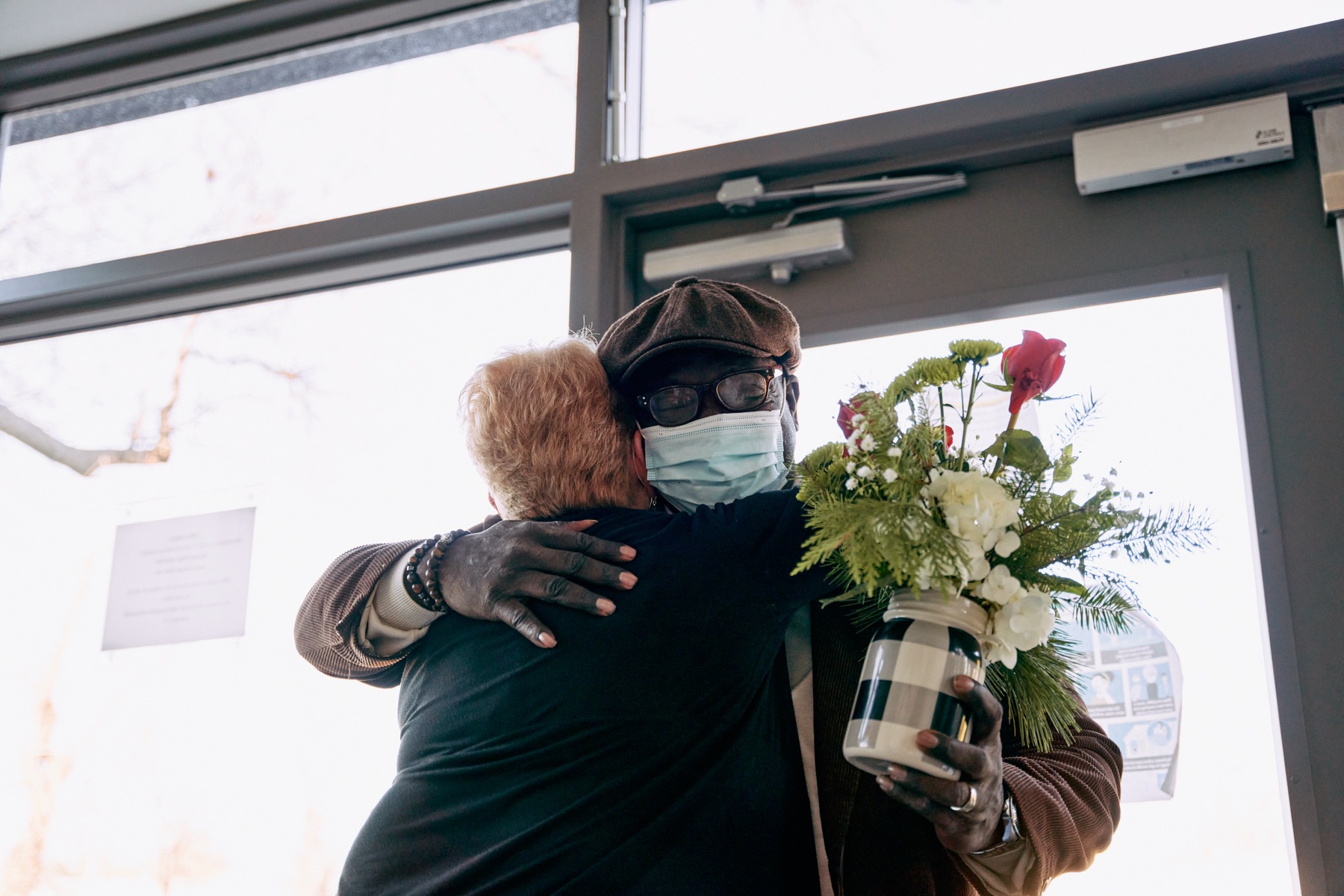
KHN (Kaiser Health News) is a national newsroom that produces in-depth journalism about health issues. Together with Policy Analysis and Polling, KHN is one of the three major operating programs at KFF (Kaiser Family Foundation). KFF is an endowed nonprofit organization providing information on health issues to the nation.
 Update 8/21/23: This piece, by KFF Health News and Science Friday, won the National Association of Black Journalists Salute to Excellence Award.
Update 8/21/23: This piece, by KFF Health News and Science Friday, won the National Association of Black Journalists Salute to Excellence Award.
Invest in quality science journalism by making a donation to Science Friday.
Rae Ellen Bichell is Colorado Correspondent for Kaiser Health News in Longmont, Colorado.
Cara Anthony is Midwest Correspondent for Kaiser Health News in St. Louis, Missouri.
JOHN DANKOSKY: This is Science Friday. I’m John Dankosky. Doctors, scientists, and lawmakers are debating how to approach the use of race in medical care. Some of the ways it’s used in medicine is based on a big assumption that bodies of different races work differently on some sort of fundamental level. Rae Ellen Bichell and Cara Anthony are reporters with Kaiser Health News, who’ve been covering this. Welcome, both of you, to Science Friday.
RAE ELLEN BICHELL: Thank you.
CARA ANTHONY: Thanks for having us.
JOHN DANKOSKY: Your story says that a patient’s race shows up all over the place, like in the opening line of a doctor’s notes or describing who a patient is, but also in places that are less obvious like algorithms that are used to estimate how well your lungs or kidneys are working. So how did we get here with race being such a big part of medicine?
RAE ELLEN BICHELL: Some of it is just outdated science, but also healthcare, it reflects our culture. And race is a big part of our culture and has been for a long time. Dr. Amaka Eneanya is a kidney doctor with Fresenius Medical Care. And she really traced the history of how race settled into medicine as this biological concept.
She and her colleagues say that race can be a helpful concept when used in the right way. So like how it can help identify whether certain groups of people are experiencing racism and subsequently getting different treatment. But that said, race does not tell you how somebody’s body works on a fundamental level. Here’s Dr. Eneanya.
AMAKA ENEANYA: History is being written right now that this is not the right thing to do and that the path forward is to use race responsibly and not to do it in the way that we’ve been doing it in the past.
JOHN DANKOSKY: Hmm.
CARA ANTHONY: Researchers have found that race gets confused with biology in all sorts of specialties, from bones to hearts to lungs. And for more than a year, we’ve been looking into kidney disease.
JOHN DANKOSKY: So why are you focusing on kidney disease?
RAE ELLEN BICHELL: Well, there are a ton of equations in this specialty that involve race. They’re called race adjustments or corrections sometimes. And people in this field have been talking a lot about them lately.
Just to give you one example, one equation that really stuck out to us, it tries to estimate how long transplanted kidneys would last. So it basically asked the question, how good are these kidneys going to be? And the equation downgrades kidneys coming from a Black person, as if being Black was a condition, and on top of that, as if it was a condition more dangerous than diabetes.
So one person who says this kind of thinking makes absolutely no sense is Dr. Vanessa Grubbs. And she’s a kidney doctor with the University of California, San Francisco.
VANESSA GRUBBS: If you had two harvested kidneys, one from a Black person, one from a white person, just laying on a table, you would see no difference. And there is no gene that you can test for race. There just simply is not.
CARA ANTHONY: Grubbs is one of many doctors who’s been really vocal about this issue. And there’s a really important reason for that. There are stark racial disparities, like how Black Americans are more than twice as likely than white Americans to have their kidneys fail badly enough that they need a transplant. But Black people are also less likely to get a transplant, especially from a living donor, which is really considered best for survival.
RAE ELLEN BICHELL: So there’s a nuanced distinction here, but the message that experts in the field really want to get out is that racial disparities in health do not reflect differences in biology. So what they can reflect is a group of people’s exposure to racism or a group of people’s generational lack of access to stable housing, nutritious food, which can have this domino effect on health. What they’re saying is that you wouldn’t look at gender pay gaps and assume one gender is fundamentally more capable of hard work. Rather, those show you more who tends to get the opportunities.
JOHN DANKOSKY: So let’s talk about why this misperception that race equals biology is a problem. Can that misperception actually harm patients?
RAE ELLEN BICHELL: Well, for some people, it can delay them getting the right treatment or getting the right diagnosis. That matters because kidney disease can really affect your life. Until they can get a transplant, a lot of people have to spend hours each week doing dialysis.
And typically, that means going to a dialysis center to get your blood cleaned. It can take hours each time. And you do it multiple times a week. All of that can make it really hard to work a regular schedule. It can affect energy levels. It can limit your ability to travel. COVID made it pretty scary, too. So this is a condition that can really define what a person can do. Now, in our story, we focused on one case to just figure out where race came up.
CARA ANTHONY: Yeah, the patient we followed, his name is Alphonso Harried. He’s from St. Louis and found out that he had kidney disease about five years ago and needed a transplant. Amazingly, his former boss, her name is Pat Holterman-Hommes. She wanted to donate one of her kidneys. We followed along to figure out where race came up in their case. Alphonso is Black, and Pat is white. I called Alphonso the day that he found out that Pat was a match.
ALPHONSO HARRIED: Hey, Cara, how are you doing?
CARA ANTHONY: I heard it’s a good day for you!
ALPHONSO HARRIED: It’s a phenomenal day.
CARA ANTHONY: When Alphonso heard the news, he purchased a thank you gift for Pat– fresh flowers for the person who would give him a fresh start in life, except he left them laying around. His wife, Natasha, says she found them first.
NATASHA HARRIED: I walked in and I saw the flowers on the counter. And I said, oh, this is nice. I said, who are these for, trying to be coy. And he said, those are for Pat. And I said, oh, they’re not for me? He said, no, you didn’t give me a kidney.
[LAUGHTER]
CARA ANTHONY: Pat did finally get those flowers when she saw Alphonso and his wife in person.
Pulling up, you’re like, there!
PAT HOLTERMAN-HOMMES: I know. I was so excited. I haven’t seen Al, except on Zoom, for a couple of years. So it was great to see him.
CARA ANTHONY: Race was on their minds when they sat down to talk about the surgery.
PAT HOLTERMAN-HOMMES: I wondered if our racial difference, the fact that Al’s Black and I’m white, would be a barrier.
CARA ANTHONY: Natasha wondered, too.
NATASHA HARRIED: I did. I looked it up to see, her not being a family member and then being of a different race, if that would have an impact.
CARA ANTHONY: Race comes up a lot in life, way beyond healthcare, on job applications, in school, when you apply for a loan. Alphonso says when he sees that race box that he’s supposed to check, he’s not always sure why it’s there. And it irks him.
ALPHONSO HARRIED: If I’m trying to get treatment for kidney failure, why does it matter whether I’m Black or white or Hispanic?
CARA ANTHONY: He wouldn’t mind sharing that information if he understood why doctors were asking about his race.
ALPHONSO HARRIED: But that’s never explained, so I’ll leave it blank sometimes, when I feel rebellious.
CARA ANTHONY: Alphonso wants his doctors to see more than his race.
ALPHONSO HARRIED: I serve as a big brother. I serve as a little brother. I serve as a listener and sometimes as a talker.
CARA ANTHONY: And now, when he’s talking with his doctors, he isn’t afraid to ask about race.
ALPHONSO HARRIED: Just keep your eyes open, ask questions, and inquire, just inquire about things.
CARA ANTHONY: And John, I actually tried that myself. I’m a Black woman, and I brought up race and kidney disease testing with my own doctor because in our reporting, we heard that it can be really useful for patients to do just that, to ask how race is being used in their care. My doctor was a little surprised, but we ended up having a really good conversation. And that appointment changed the way we talk to each other.
JOHN DANKOSKY: Hmm, it’s interesting. I’m glad that you were able to have that conversation. Let’s get back to Alphonso and Pat. So where did race show up in their case as they were on the way to this kidney transplant?
RAE ELLEN BICHELL: Well, one place that really stood out to us was this info packet that the hospital gave to Pat when she was just starting out trying to qualify as a donor. And this packet said people with high blood pressure who are Black can’t donate. But it also said people with high blood pressure who are white could potentially donate with extra testing. What we’ve learned is that that kind of race-based distinction is just not scientifically sound. It’s kind of like if you said, OK, people of a certain religion with high blood pressure can’t donate, but people with this other religion could.
And all of this is important because getting a transplant from a living donor, as Cara said, gives someone the best chance of surviving. And using race without a biological basis as a reason to exclude donors could decrease the pool of people that are available to donate a living organ. If you take this one step further, that’s a problem because as long as race is used as a stand-in for someone’s ancestry or genetics, then the line between protecting and excluding certain groups will be fuzzy.
JOHN DANKOSKY: So what do experts say about how race should actually be used in medicine?
CARA ANTHONY: Yeah, we talked to Dr. Lisa McElroy, who is a surgeon at Duke University who performs kidney transplants there. This is how she thinks about race in her practice.
LISA MCELROY: When I see a Black patient in the clinic, I don’t ignore the fact that they’re Black. I might spend a little bit extra time in the room emphasizing the importance of living donation.
CARA ANTHONY: Just like how she might spend more time with a Spanish-speaking patient, making sure they know how to access a translator, and she says the goal here is not to ignore the social determinants of health, like race, it’s to help patients overcome the obstacles that can keep them from getting good care.
JOHN DANKOSKY: But before I let you go, I have to ask, how are Pat and Al doing?
CARA ANTHONY: They’re both doing great. I check in with them all the time. And the road to recovery has been really smooth for both of them.
JOHN DANKOSKY: That’s really good to hear. I want to thank you both for bringing us this story. Cara Anthony and Rae Ellen Bichell are reporters with Kaiser Health News. Thank you both so much.
CARA ANTHONY: Thanks for having us.
RAE ELLEN BICHELL: Thanks for having us.
JOHN DANKOSKY: And if you want to read their full story on this topic, you can head to our website at sciencefriday.com/raceinmedicine.
Copyright © 2022 Science Friday Initiative. All rights reserved. Science Friday transcripts are produced on a tight deadline by 3Play Media. Fidelity to the original aired/published audio or video file might vary, and text might be updated or amended in the future. For the authoritative record of Science Friday’s programming, please visit the original aired/published recording. For terms of use and more information, visit our policies pages at http://www.sciencefriday.com/about/policies/
Kathleen Davis is a producer and fill-in host at Science Friday, which means she spends her weeks researching, writing, editing, and sometimes talking into a microphone. She’s always eager to talk about freshwater lakes and Coney Island diners.
John Dankosky works with the radio team to create our weekly show, and is helping to build our State of Science Reporting Network. He’s also been a long-time guest host on Science Friday. He and his wife have three cats, thousands of bees, and a yoga studio in the sleepy Northwest hills of Connecticut.